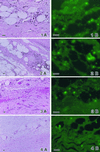Detection of Treponema denticola in atherosclerotic lesions
- PMID: 11230436
- PMCID: PMC87882
- DOI: 10.1128/JCM.39.3.1114-1117.2001
Detection of Treponema denticola in atherosclerotic lesions
Abstract
We examined 26 atherosclerotic lesions and 14 nondiseased aorta specimens to detect the periodontopathogenic part of the bacterial 16S rRNA locus by PCR. Treponema denticola sequence of the 16S rRNA locus was found in 6 out of 26 DNA samples (23.1%) from the formalin-fixed, paraffin-embeded atherosclerotic lesions obtained during surgery but not in any of the 14 nondiseased aorta samples from deceased persons. Utilizing immunofluorescence microscopy, we observed aggregated antigenic particles reacting with rabbit antiserum against T. denticola in thin sections of the PCR-positive samples, but we could not detect any reacting particles in the PCR-negative thin sections.
Figures


References
-
- Ashimoto A, Chen C, Slots J. Polymerase chain reaction detection of 8 putative periodontal pathogens in subgingival plaque of gingivitis and advanced periodontitis lesions. Oral Microbiol Immunol. 1996;11:266–273. - PubMed
-
- Beck J, Garcia R, Heiss G, Vokomas P S, Offenbacher S. Periodontal disease and cardiovascular disease. J Periodontol. 1996;67:1123–1137. - PubMed
-
- Chiu B. Multiple infection in carotid atherosclerotic plaques. Am Heart J. 1999;138:S534–S536. - PubMed
-
- Coles K A, Plant A J, Riley T V, Smith D W. Cardiovascular disease: an infectious aetiology. Med Microbiol. 1998;9:17–27.
Publication types
MeSH terms
Substances
LinkOut - more resources
Full Text Sources
Molecular Biology Databases

